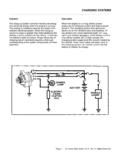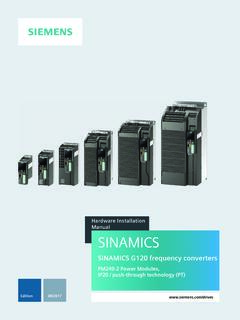Transcription of AD598 LVDT Signal Conditioner - Analog Devices
1 PRODUCT DESCRIPTIONThe AD598 is a complete, monolithic Linear Variable Differen-tial Transformer (LVDT) Signal conditioning subsystem. It isused in conjunction with LVDTs to convert transducer mechan-ical position to a unipolar or bipolar dc voltage with a highdegree of accuracy and repeatability. All circuit functions areincluded on the chip. With the addition of a few external passivecomponents to set frequency and gain, the AD598 converts theraw LVDT secondary output to a scaled dc Signal . The devicecan also be used with RVDT AD598 contains a low distortion sine wave oscillator todrive the LVDT primary. The LVDT secondary output consistsof two sine waves that drive the AD598 directly. The AD598operates upon the two signals, dividing their difference by theirsum, producing a scaled unipolar or bipolar dc AD598 uses a unique ratiometric architecture (patent pend-ing) to eliminate several of the disadvantages associated withtraditional approaches to LVDT interfacing.
2 The benefits of thisnew circuit are: no adjustments are necessary, transformer nullvoltage and primary to secondary phase shift does not affect sys-tem accuracy, temperature stability is improved, and transducerinterchangeability is AD598 is available in two performance grades:GradeTemperature Range PackageAD598JR 0 C to +70 C20-Pin Small Outline (SOIC)AD598AD 40 C to +85 C20-Pin Ceramic DIPIt is also available processed to MIL-STD-883B, for the militaryrange of 55 C to +125 BLOCK DIAGRAMOSCAMPAMPVOUTLVDTEXCITATION (CARRIER)1117101623 FILTERA BA+BVBVAAD598 REV. AInformation furnished by Analog Devices is believed to be accurate andreliable. However, no responsibility is assumed by Analog Devices for itsuse, nor for any infringements of patents or other rights of third partieswhich may result from its use.
3 No license is granted by implication orotherwise under any patent or patent rights of Analog SignalConditionerAD598 One Technology Way, Box 9106, Norwood, MA 02062-9106, : 617/329-4700 Fax: 617/326-8703 PRODUCT HIGHLIGHTS1. The AD598 offers a monolithic solution to LVDT andRVDT Signal conditioning problems; few extra passive com-ponents are required to complete the conversion from me-chanical position to dc voltage and no adjustments The AD598 can be used with many different types ofLVDTs because the circuit accommodates a wide range ofinput and output voltages and frequencies; the AD598 candrive an LVDT primary with up to 24 V rms and accept sec-ondary input levels as low as 100 mV The 20 Hz to 20 kHz LVDT excitation frequency is deter-mined by a single external capacitor.
4 The AD598 input sig-nal need not be synchronous with the LVDT primary means that an external primary excitation, such as the400 Hz power mains in aircraft, can be The AD598 uses a ratiometric decoding scheme such thatprimary to secondary phase shifts and transducer null voltagehave absolutely no effect on overall circuit Multiple LVDTs can be driven by a single AD598 , either inseries or parallel as long as power dissipation limits are notexceeded. The excitation output is thermally The AD598 may be used in telemetry applications or in hos-tile environments where the interface electronics may be re-mote from the LVDT. The AD598 can drive an LVDT atthe end of 300 feet of cable , since the circuit is not affectedby phase shifts or absolute Signal magnitudes.
5 The positionoutput can drive as much as 1000 feet of The AD598 may be used as a loop integrator in the design ofsimple electromechanical servo Chip Solution, Contains Internal Oscillator andVoltage ReferenceNo Adjustments RequiredInsensitive to Transducer Null VoltageInsensitive to Primary to Secondary Phase ShiftsDC Output Proportional to Position20 Hz to 20 kHz Frequency RangeSingle or Dual Supply OperationUnipolar or Bipolar OutputWill Operate a Remote LVDT at Up to 300 FeetPosition Output Can Drive Up to 1000 Feet of CableWill Also Interface to an RVDTO utstanding PerformanceLinearity: of FS maxOutput Voltage: 611 V minGain Drift: 50 ppm/8C of FS maxOffset Drift: 50 ppm/8C of FS maxAD598 SPECIFICATIONS(typical @ +258C and 615 V dc, C1 = mF, R2 = 80 kV, RL = 2 kV,unless otherwise noted.)
6 See Figure 7.)REV. A 2 AD598J AD598 AParameterMinTypMaxMinTypMaxUnitTRANSFER FUNCTION1 VOUT=VA VBVA+VB 500 A R2 VOVERALL ERROR2 TMIN to of FSSIGNAL OUTPUT CHARACTERISTICSO utput Voltage Range (TMIN to TMAX)611611 VOutput Current (TMIN to TMAX)86mAShort circuit Current2020mANonlinearity3 (TMIN to TMAX)756500756500ppm of FSGain of FSGain Drift20610020650ppm/ C of of FSOffset Drift762007650ppm/ C of FSExcitation Voltage Rejection6100100ppm/dBPower Supply Rejection ( 12 V to 18 V)PSRR Gain (TMIN to TMAX)300100400100ppm/VPSRR Offset (TMIN to TMAX)1001520015ppm/VCommon-Mode Rejection ( 3 V)CMRR Gain (TMIN to TMAX)1002520025ppm/VCMRR Offset (TMIN to TMAX)10062006ppm/VOutput Ripple744mV rmsEXCITATION OUTPUT CHARACTERISTICS (@ kHz)Excitation Voltage rmsExcitation Voltage(R1 = Open) rms(R1 = k ) rms(R1 = 487 )814201420V rmsExcitation Voltage TC9600600ppm/ COutput Current3030mA rmsTMIN to TMAX1212mA rmsShort circuit Current6060mADC Offset Voltage (Differential, R1 = k )TMIN to TMAX306100306100mVFrequency2020k2020kHzF requency TC, (R1 = k )200200ppm/ CTotal Harmonic Distortion 50 50dBSIGNAL INPUT CHARACTERISTICSS ignal rmsInput Impedance200200k Input Bias Current (AIN and BIN)1515 ASignal Reference Bias Current210210 AExcitation Frequency020020kHzPOWER SUPPLY REQUIREMENTSO perating Range13361336 VDual Supply Operation ( 10 V Output)
7 13 13 VSingle Supply Operation0 to +10 V to 10 V (No Load at Signal and Excitation Outputs)12151215mATMIN to TMAX1618mATEMPERATURE RANGEJR (SOIC)0+70 CAD (DIP) 40+85 CPACKAGE OPTIONSOIC (R-20) AD598 JRSide Brazed DIP (D-20) AD598 ADNOTES1VA and VB represent the Mean Average Deviation (MAD) of the detected sine waves. Note that for this Transfer Function to linearly represent positive displacement,the sum of VA and VB of the LVDT must remain constant with stroke length. See Theory of Operation. Also see Figures 7 and 12 for TMIN, to TMAX, the overall error due to the AD598 alone is determined by combining gain error, gain drift and offset drift. For example the worst case overallerror for the AD598AD from TMIN to TMAX is calculated as follows: overall error = gain error at +25 C ( 1% full scale) + gain drift from 40 C to +25 C (50 ppm/ Cof FS +65 C) + offset drift from 40 C to +25 C (50 ppm/ C of FS +65 C) = of full scale.
8 Note that 1000 ppm of full scale equals of full scale is defined as the voltage difference between the maximum positive and maximum negative of the AD598 only, in units of ppm of full scale. Nonlinearity is defined as the maximum measured deviation of the AD598 output voltage from astraight line. The straight line is determined by connecting the maximum produced full-scale negative voltage with the maximum produced full-scale positive Transfer offset refers to the (VA VB)/(VA+VB) input spanning a full-scale range of 1. [For (VA VB)/(VA+VB) to equal +1, VB must equal zero volts; and correspondinglyfor (VA VB)/(VA+VB) to equal 1, VA must equal zero volts. Note that offset errors do not allow accurate use of zero magnitude inputs, practical inputs are limited to100 mV rms.]
9 ] The 1 span is a convenient reference point to define offset referred to input. For example, with this input span a value of R2 = 20 k would giveVOUT span a value of 10 volts. Caution, most LVDTs will typically exercise less of the ((VA VB))/((VA+VB)) input span and thus require a larger value of R2 toproduce the 10 V output span. In this case the offset is correspondingly magnified when referred to the output voltage. For example, a Schaevitz E100 LVDT requires k for R2 to produce a V output and (VA VB)/(VA+VB) equals This ratio may be determined from the graph shown in Figure 18,(VA VB)/(VA+VB) = ( V rms V rms)/( V rms + V rms). The maximum offset value referred to the V output may be determined bymultiplying the maximum value shown in the data sheet ( 1% of FS by 1 which equals maximum.)
10 Similarly, to determine the maximum values of offsetdrift, offset CMRR and offset PSRR when referred to the V output, these data sheet values should also be multiplied by (1 ). For this example for theAD598AD the maximum values of offset drift, PSRR offset and CMRR offset would be: 185 ppm/ C of FS; 741 ppm/V and 741 ppm/V respectively when referredto the V example, if the excitation to the primary changes by 1 dB, the gain of the system will change by typically 100 ripple is a function of the AD598 bandwidth determined by C2, C3 and C4. See Figures 16 and is shown in Figures 7 and voltage drift is not an important specification because of the ratiometric operation of the subject to change without shown in boldface are tested on all production units at final electrical test.














